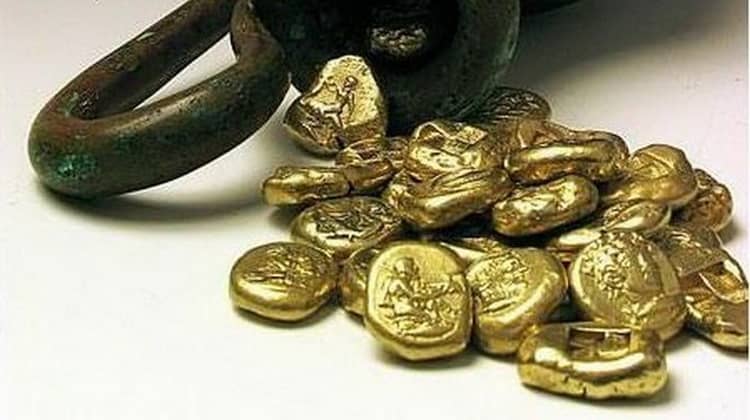
Stater (Greek. στατήρ – literally “weight”) – the heritage of Ancient Greece and Lydia from the beginning of the fifth century BC and to the middle of the first century AD . This monetary unit has a historical value – it helps to learn more about religious beliefs and cults, economic and political relations in the ancient world.
History
Ancient coin stater is the oldest coin, which was the standard of the monetary unit in Europe and Asia for a long time. The first copy, according to archaeologists, was made about 3,200 years ago on the territory of the Lydian kingdom due to successful location of the empire at the intersection of trade routes between the West and the East. The availability of a single currency significantly simplified the exchange of goods on an international level. This was evidenced by the impressive area of distribution and the variety of major types of coins.
Lydian stater received the status of “the first coin of the world”. It had (for its time) a defined size, face value and weight. Electrum (precious metal that was valued in trade and known for its durability) was chosen for its minting. In particular, Aliatta, the first king, who started the minting of the monetary unit, established a norm of weight for the coin-168 grains of wheat (about 14 grams). Later, the price for a gold stater was determined by the monetary standard and the place of minting.

After Lydia, coins were minted in Pamphylia, a coastal region that was bordering Lydia. The mint produced the stater of the city of Aspend, a settlement that was then under the influence of Athens. Scientists have calculated that the Aspendian staters wrestlers are depicted in no less than 16 positions. This feature emphasizes not only the importance of sport events in the culture of that time, but also the skill of engravers.

In 510-485 BC the Greeks adopted the method of minting and began to issue their own staters, the first of which were used on the island of Aegina. With the advent of Alexander the Great, the stater spread throughout the territory known at the time. Since that time, the image of the ruling monarch on coins has become a pervasive practice. The authority of the monarch was so great that even with the power of his associate Lysimachus , the stater was minted with Alexander’s portrait.
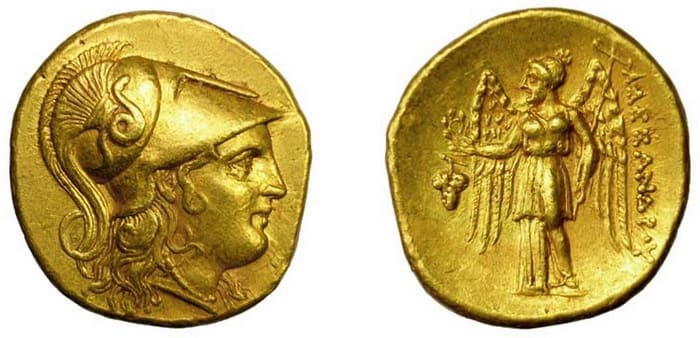
Do you know?
During the conquests of Alexander the Great, the expense of one day of his army was 20 talents. It was120,000 drachmas or 60,000 staters. The total cost of the whole company is estimated at 240,000,000 staters.
Gold coins were becoming more common. The monetary unit was minted in its own way almost in each polis and with each king. There are at least 50 types (for the entire period of minting) of staters of the Bosporus Kingdom only. Money had circulation not only in Greece, but also in ancient Rome. A vivid example is the golden staters of the Venetis , the Celtic tribe, whose inhabitants lived in the Armorica region (the modern Brittany peninsula in north-west France).
Do you know?
The purchase of land with a house on the outskirts of Greece – in Amphipolis, cost 12 staters. The house in Athens cost from 200-500 coins (the price could reach 1,400). Thus, it was profitable to settle far away from the center, and buy slaves with the saved money. The price of one slave was 100-150 staters. The price was regularly raised: in 14 BC a slave cost 500 staters, and by the year 5 AD reached a mark of 600 coins.
The fall of the Avernian empire gave rise to mints in large cities, from where coins were distributed to regions. Venetis earned this exceptional role of the mediator between the island and continental countries of the Atlantic due to their wealth and power. They were the first in Armorica to mint a coin, issuing gold staters first and then the silver ones. Since then, almost all surrounding territories have been provided with coins.
Design
Stater was minted in several areas of Lydia and Greece. The image on the coins varied depending on the region. Also the size and material changed depending on the place of minting and features of the mint. Initially, money was made from electrum – an alloy of gold and silver in a ratio of 4 to 1 and 3 to 1. Later, craftsmen learned to divide precious metals, and the amount of silver was 10%.
The Bosporus staters were minted almost of pure gold, but over time, a degradation of metal was observed. Constant wars forced to save, so the gold fineness gradually decreased. In 131 the money was issued from the bilon (silver mixed with copper), and the last coins were made entirely from copper.
There is a general trend in design of all coins, consisting of several points:

- circle of a coin is not always ideally round;
- images profile only on the obverse and reverse;
- no edge (because of technical features of the minting of that time);
- images of gods and goddesses (up to 68-91, when minting of gold stater with the images of kings and queens of the Bosporus state started).
Despite the fact that the stater was the first minted coin, and the engravers had to use a limited number of tools, the craftsmen treated the image punch responsibly and paid attention to the details. The skill and naturalness of the lines can be seen in each copy. Thanks to this, ancient money has acquired a unique cultural value in the world of numismatics.
Golden stater of Panticapaeum, which is a miracle of portraiture of the Bosporus kingdom, serves as a good example. The obverse of the coin depicts a Satyr with a face turned in 3/4, and not in profile. The master was able to convey the features of the forest deity and his expression (sadness). The hair, nose, beard and eyes of the creature are thoroughly detailed. On the reverse there is an inscription PAN and a griffin, deployed to the left with a spear in the mouth. This copy became the most expensive in the history of the antique coin (sold at an auction for $ 3,250,000).
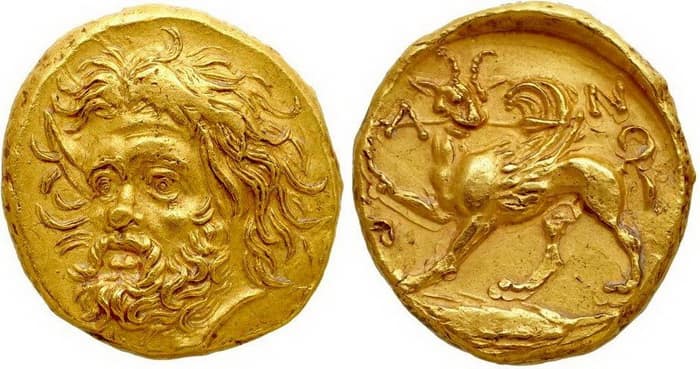
Another notable coin of the Bosporus is the stater of the Savromat . It is easy to recognize it by the presence on the reverse of two portraits (the other coins contained only one portrait). Busts of Septimius Severus and Caracalla (father and son) are engraved on the surface.
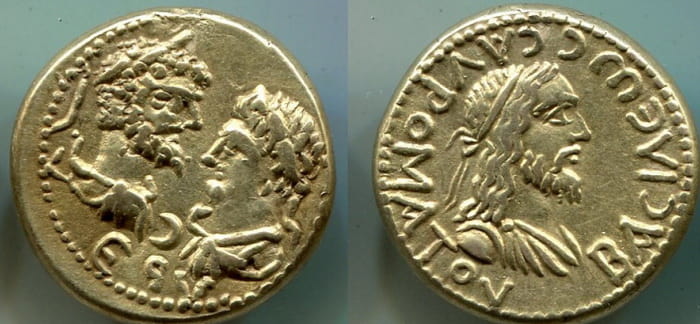
Do you know?
Panticapaean stater is one of the most significant coins in the numismatics of ancient Greece. The griffin, the legendary keeper of gold mines in the religion of the Scythians, is depicted on the reverse. Gold was mined in the region of Central Asia, where modern paleontologists discovered fossils of the Protoceratops dinosaur. This dinosaur was the size of a lion and had a head indistinguishable from the head of an eagle. It is likely that the Scythians could find fossils in the process of gold mining. This led to the fact that the beast became a mythical keeper of hidden sources of gold for them.
Stater (Lydia) 610-546 BC
- Metal : electrum (gold – 55%, silver – 45%)
- Weight : ap.14 g
- Diameter : 13 mm
- Obverse : head of a lion is 610-561 BC (head of a lion and a bull in 561-46 BC)
- Reverse : two rectangles
Stater (Greece)510-140 BC
- Metal : silver and electrum (gold – 55%, silver – 45%)
- Weight : 12 g
- Diameter : 18 mm
- Obverse : sea turtle
- Reverse : segmented square (sometimes divided into 5 triangles)
Stater (Kizik town) ap. 600-330BC
- Metal : electrum (gold – 55%, silver – 45%)
- Weight : 16 g
- Diameter : 18 mm
- Obverse and reverse : images of kings and political leaders of that time (often), images of mythical creatures and gods (the obverse and reverse often switch places depending on the century and place of minting), as well as images of animals (less often)
Stater (Bosporus Kingdom, Panticapaeum) 369BC – 220 AD
- Metal : electrum, gold, silver
- Weight : 9-10 g
- Diameter : 18-21 mm
- Examples of obverse : the male head to the left (to the right), the head of Satyr to the left (to the right), the portraits of the kings to the left (to the right)
- Examples of reverse : Apollo on the throne (to the left), Artemis on the throne (to the left), Nick with a wreath and a branch, the head of Agrippa (to the right), various attributes (ear, spear, lyre, point).
Few names of engravers survived, but on some ancient gold and silver coins of Ancient Greece there were signatures of such masters as Evaineet, Kimon, Theodotus.
Circulation
Lydian coins have been preserved in a small circulation – from 1 to 12 coins. Most of them kept in museums, some copies have been bought for private collections.
Samples of Greek minting are not a numismatic rarity. The development of the technique of minting and the increase in skill of engravers made it possible to produce a large number of coins. The most common were the Aeginiain, Corinthian, and Macedonian staters. The mint lasted for 250 years.
Do you know?
A scarce item is the Melos staler. During the Peloponnesian War, the inhabitants of this island tried to remain neutral to military events and did not adhere to either Athens or Sparta. Eventually, the polis was won by the Athenians in 416-415. The male half of the island was put to death, women and children were enslaved. Most of the coins were melted, only a few copies survived.
The cost
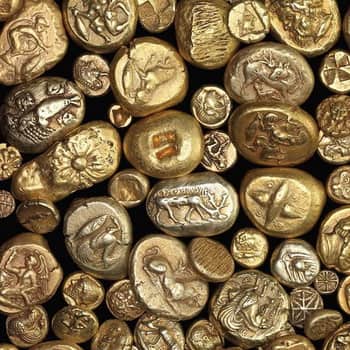
- Panticapaeum (350-300 BC) gold stater 9.12 g – 3,250,000 $;
- Panticapaeum (340-325 BC) gold stater 9.10 g – 120,000 $;
- Bosporus Kingdom, Rescuporide (211-226 BC) electrum stater 9 g – 4,000 $;
- Macedonia, Alexander III the Great (336-323 BC) gold stater 8.58 g – 7,500 $;
- Macedonia, Alexander III the Great (336-323 BC) gold stater 8.52 g – 5,500 $;
- Macedonia, Antigonus II Gonath (277-239 BC) gold stater 8.59 g – 65,000 $;
- Lydia, Croesus (561-546 BC) gold stater 10.52 g – 27,500 $;
- Corinth (550-500 BC) silver stater 8.56 g – 90,000 $;
- Corinth (500 гг. BC) silver stater 8.48 g – 2,000 $;
- Corinth (400-375 BC) silver stater 8.53 g – 3,000 $;
- Corinth (400-375 BC) silver stater 8.60 g – 40,000 $.
Comments
No commens yet.